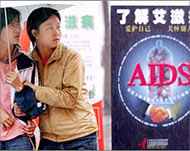Experts: India, China face HIV rise
With their growing economies leading to greater exchanges with the outside world, China and India are at the frontline in the fight to prevent an explosion of new HIV infections, experts at an Aids conference said on Monday.

The world’s two most populous nations have low infection rates in percentage terms, which spells danger as policymakers may not see the scale of the HIV problem when viewed by the raw number of cases.
“These two are very large countries. Even small prevalence of HIV infections can mean a huge number of affected people,” said J V R Prasada Rao, director of the Asia-Pacific regional support team at the Joint UN Programme on HIV/Aids (UNAIDS).
Because of the low infection rates, “it is a big challenge to sensitise the political leadership of the two countries”, Rao, a former top health policymaker in India, said on the sidelines of the conference in Kobe, Japan.
 |
|
Fighting HIV/Aids is still not a |
Asia accounts for roughly 20%, or 8.2 million people, of the 40 million people infected with HIV worldwide. But the prevalence rate remains a relatively low 0.4% of the adult population, according to UNAIDS.
China officially has an estimated 840,000 people infected with HIV, including 80,000 with full-blown Aids. The prevalence rate is 0.1%.
Epidemics feared
But the Asian economic dynamo might face what may be one of the largest HIV/Aids epidemics in the world, with experts predicting more than 10 million Chinese could be infected with HIV by 2010.
Premier Wen Jiabao last month said China was “determined and capable” of controlling HIV.
India has more than 5.13 million people living with HIV/Aids, second only to the number in South Africa with 5.3 million cases.
But the South Asian country’s prevalence rate was at 0.9% of adults, compared with South Africa’s 21.5%, UNAIDS said.
The rapid economic growth of China and India has triggered greater exchanges of people, with migrant workers at particular risk of infection, UNAIDS said in a report.
Little action
Sex education, condom distribution and needle exchanges are proven parts of anti-HIV programmes, but with low infection rates policymakers may not feel pressure to pursue such ideas, said Shigeru Omi, director for the Western Pacific at the World Health Organisation.
|
“These two are very large countries. Even small prevalence of HIV infections can mean a huge number of affected people” J V R Prasada Rao, |
“Aids is a very difficult problem,” he said. “It has the image of sex, gay sex and IV (intravenous) drug users.”
Rao said India had no “organised opposition” to anti-AIDS programmes but efforts were inconsistent.
“In some provinces, they are not doing anything. Their political leadership are not sensitised.
Richard Feachem, executive director of the Global Fund to Fight Aids, Tuberculosis and Malaria, called on Asian leaders to back their vocal support for measures to fight Aids with action.
“This is not a poor region. But political priorities put on HIV/Aids is too low,” he said. “It is a question of political choice and political priority.”
The Seventh International Congress on HIV/Aids in Asia and the Pacific started in Kobe on Friday and ends Tuesday.